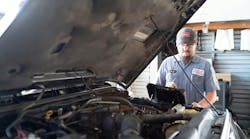With the smartness of machines and “Internet of Things,” proactive maintenance is quickly becoming the buzzword for facilities’ maintenance managers and reliability engineers. There are two components to proactive maintenance – preventive maintenance (PM) and predictive maintenance (PdM). Corrective maintenance (fix it when its broken) evolved to preventive maintenance (PM) and has roots going back to the Industrial Revolution, when equipment reliability became a concern after the manufacturing boom and use of machinery. PM was regularly performed on a piece of equipment to lessen the likelihood of it failing. Preventive maintenance is performed while the equipment is still working so that it does not breakdown unexpectedly. The primary goal is to mitigate the consequences of equipment failure. Preventive maintenance may utilize some proactive technologies. However, it still remains primarily a calendar-based (or operating hours) approach, rather than a condition-based one.
Preventive Maintenance
For example, a motor is driving a critical operation that cannot have significant downtime. Based on the motor and bearing design, the manufacturer recommends that the drive bearing be changed after 25,000 hours of runtime. Just before or at 25,000 hours, the motor bearing is changed during a scheduled downtime. This is an example of scheduled preventive maintenance.
In the same scenario, if the motor maintenance is ignored until it fails completely and is replaced during an unplanned shutdown, this would be corrective (or reactive) maintenance.
Predictive Maintenance
With the same example, by using various technologies to measure motor winding temperature, bearing temperature, amperage, and bearing vibration, the data is collected on regular intervals and trended. After 35,000 hours, there is a rise in some of the data points compared to the baseline. It is predicted that the motor will “fail” as the motor conditions exceed design point conditions. The bearing is then replaced during a planned shutdown. By using the predictive maintenance method—examining data trends and performing maintenance based on conditional limits—the significant costs of the shutdown and replacement bearing were delayed until a point at which the equipment could no longer be expected to reliably perform at the required functional level—in other words, below design performance.
There are many key components to PdM based on the technologies available. The top five can be categorized for rotating equipment and can be applied to equipment supporting critical processes that cannot afford costly downtime and yet do not have redundancy.
1. Vibration analysis
2. Infrared sensing
3. Lubrication sampling
4. Power Quality Analysis
5. Motor winding test
By collecting and evaluating the data, companies can replace corrective or excessive maintenance with condition-based predictive maintenance. This replaces unplanned emergency downtime and production losses with properly planned downtime. Additionally, companies can better plan their spares inventory and have parts on hand that are scheduled to be changed and not every part that is assumed to be important for the equipment. Considerable labor costs associated with overtime for late night and emergency calls for breakdowns over holidays can be eliminated. Other costs such as loss of productivity to meet orders and delays in shipment can be significantly reduced through better planning.
Until we reach a point where every machine has sensors and micro-sensors to collect data and has the “Internet of Things” built-in to make sense of the data and communicate it, we will still somewhat rely on manual processes through preventive maintenance scheduling. Currently, relatively few companies (or their equipment) are ready for PdM, but it is coming. And while it may not suit everyone, supplementing the PM with PdM can greatly reduce the risk and cost of planning for many plants. Murphy and his law will find it hard to apply itself in your facility when you are proactive in your equipment maintenance.


